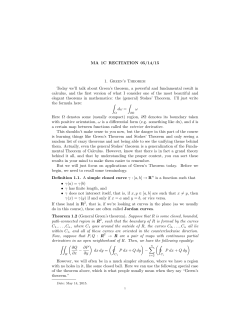
ASSIGNMENT 11 SOLUTION 1. Stewart 16.4.21 [5 pts] (1) If C is the
ASSIGNMENT 11 SOLUTION JAMES MCIVOR 1. Stewart 16.4.21 [5 pts] (1) If C is the line segment connecting the point (x1 , y1 ) to the point (x2 , y2 ), show that Z x dy − y dx = x1 y2 − x2 y1 C (2) If the vertices of a polygon, in counterclockwise order, are (x1 , y1 ), . . . , (xn , yn ), show that the area of the polygon is A= n−1 X i=1 1 1 (xi yi+1 − xi+1 yi ) + (xn y1 − x1 yn ) 2 2 Solution: (1) The segment is parametrized by r(t) = hx1 + t(x2 − x1 ), y1 + t(y2 − y1 )i (0 ≤ t ≤ 1), so dy = (y2 − y1 ) dt and dx = (x2 − x1 ) dt. Thus Z Z 1 Z 1 x dy − y dx = (x1 + t(x2 − x1 ))(y2 − y1 ) dt − y1 + t(y2 − y1 )(x2 − x1 ) dt C 0 0 1 1 = (y2 − y1 )(x1 + (x2 − x1 )) − (x2 − x1 )(y1 + (y2 − y1 )) 2 2 1 1 = [x1 y2 − x1 y1 + x2 y2 − x2 y1 ] − [x2 y1 − x1 y1 + x2 y2 − x1 y2 ] 2 2 = x1 y2 − x2 y1 (2) Let C be the boundary of this polygon, so C consists of n segments Ck , each joining (xk , yk ) to (xk+1 , yk+1 ), except for Cn , which joins (xn , yn ) to (x1 , y1 ). According to the area folrmula derived from Green’s theorem, the area of the polygon is Z Z n X 1 1 A= y dx − x dy = y dx − x dy 2 C 2 Ck k=1 R By (a), for each 1 ≤ k ≤ n − 1 we have Ck x dy − y dx = xk yk+1 − xk+1 yk , and also R x dy − y dx = xn y1 − x1 yn . Adding these up gives the desired result. Cn 2. Stewart 16.5.37 [5 pts] This exercise demonstrates a connection between the curl vector and rotations. Let B be a rigid body rotating about the z-axis. The rotation can be described by the vector w = ωk, where ω is the angular speed of B, that is, the tangential speed of any point P in B divided by the distance d from the axis of rotation. Let r = hx, y, zi be the position vector of P . (a) By considering the angle θ in the figure, show that the velocity field of B is given by v = w × r. (b) Show that v = −ωyi + ωxj. (c) Show that curl v = 2w. Solution: (a) To show that v = w × r, we show these vectors have the same direction and smae length. The velocity vector at each point is perpendicular to the line o the z-axis, and so does w × r, by the right hand rule. The length of v is the tangential speed, which is ωd. On the other hand, the length of w × r is |w||r| sin θ, since w is in the direction of the positive z-axis. But |r| sin θ = d and |w| = ω, so |w × r| = ωd = |v|, so these vectors have the same length and direction, hence are equal. 1 2 JAMES MCIVOR (b) By putting w = ωk and r = hx, y, zi into the formula for the cross product w × r, we get v = −ωyi + ωxj. (c) Again, a simple calculation using the determinant formula for the curl of v = −ωyi + ωxj gives curl v = 2w. 3. Stewart 16.6.24 [5 pts] Find a parametric repreentation of the part of the sphere x2 + y 2 + z 2 = 16 that lies between the planes z = −2 and z = 2. Solution: The sphere is described in spherical coordinates by the equation ρ = 4, which means we can use the other two spherical coordinates φ and θ as parameters, giving r(φ, θ) = h4 sin φ cos θ, 4 sin φ sin θ, 4 cos φi We need to impose the constraint that −2 ≤ z ≤ 2. Since z = 4 cos φ, this becomes −1/2 ≤ cos φ ≤ 1/2, so φ ranges from π/3 to 2π/3 (since φ is always between 0 and π). So the bounds on the parameters are 0 ≤ θ2π and π/3 ≤ φ ≤ 2π/3.
© Copyright 2025





















